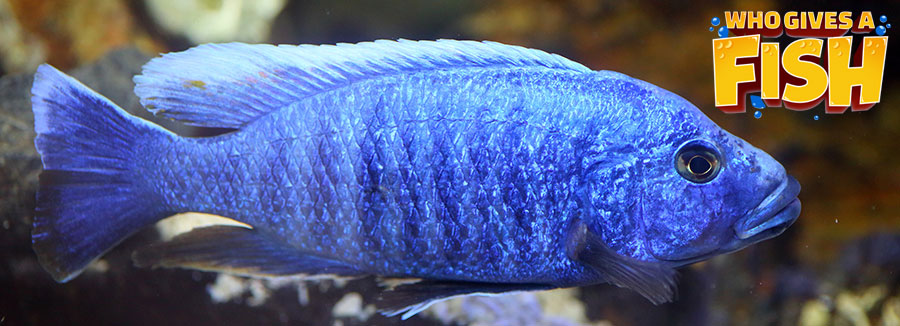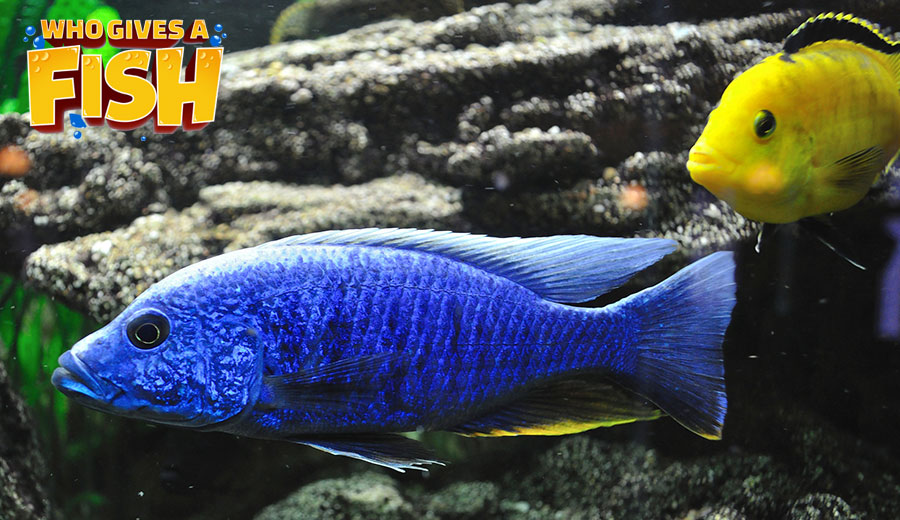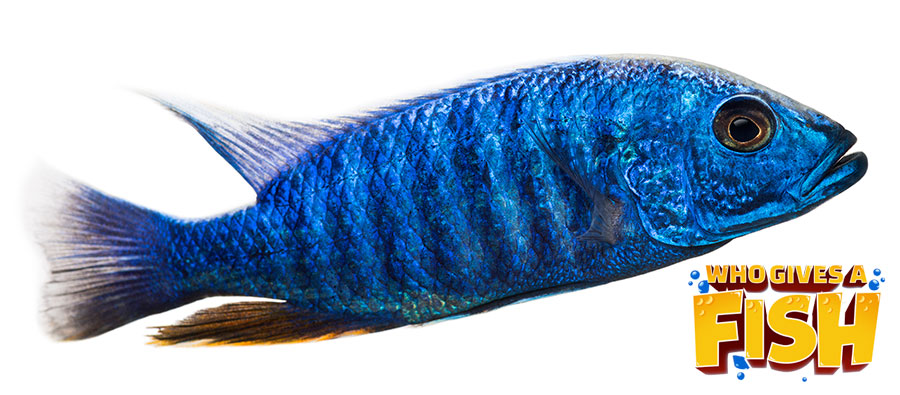Electric Blue Cichlid
Also known as the Electric Blue Hap, Sciaenochromis fryeri, the Electric Blue Cichlid is a commonly seen fish in the hobby. This is due to its beautiful blue coloration, especially when fed correctly, and its hardiness.
Originating from Lake Malawi, this species will go with most other Malawi Cichlids and usually does well in a community aquarium. It is also commonly referred to as the “Blue Hap” and simply the “Electric Blue”
- Experience Level: Beginner
- Hardiness: Moderate
- Minimum Tank Size: 30 G (115 L)
- Maximum Size: 8 in (20 cm)
- Temperament: Peaceful
- Temperature: 70 – 82° F (21.1 – 27.8° C)
- pH Range: 6.5 – 8.0
- Water Hardness: 2 – 25 dGH
- Diet: Omnivore
Table of Contents
Introduction
Aquarium Setup
Difficulty
Feeding
Breeding and Social
These are Hap Cichlids and are usually found in the more open water areas in Lake Malawi, unlike Mbuna. They still require rock work and areas to hide close by and will swim in open water close to where there is some structure.
Females are more of a silver color, although still bright and a very welcome addition to a community tank. The males are the ones who display the beautiful blue coloration.
It is advised against keeping the Electric Blue Cichlid with Peacock Cichlids as they can kill the males and crossbred with the females. Longer tanks are advised over deeper ones, and this is preferred as the fish will often swim full lengths of the tank back and forth.
It is hard to find pure breeds as these are easy fish to breed and will often cross breed in captivity. Pay close attention to the fish you intend to purchase and compare it to the many images online of a purebred Electric Blue.
Aquarium Setup
While at least 50 gallons in volume is recommended, the ideal form factor of the tank will be a rectangle with good length.
It is essential to keep the pH above 7.6 and you can keep this Cichlid in brackish water conditions. Make note to slowly increase the levels of salt however if keeping in a brackish tank, in order to properly acclimatize them. Setups with more salt in the tank will help in increasing your pH levels.
Keeping crushed coral and oyster shells in the canister filter or tank as a substrate (note that the later is harder to remove if adapting the water pH and gravity) will help increase the water hardness, and will often stimulate spawning.
Tanks with greater mineral content will do better at keeping this fish and ensuring that it is in excellent condition.
While this Cichlid will spend a lot of time in the open water, a good rock structure is required for them to hide when threatened. Most plant species will be picked at and moved around, however tough plants such as the Java Fern will do well in a tank with this Cichlid.
Electric Blue Cichlid Aquarium Guide
- Minimum Tank Size: 50 gal (190 L)
- pH Range: 7.6 – 8.6
- Water Hardness: 5 -10 dGH
- Temperature: 73 – 82° F (22.8 – 27.8° C)
- Lighting: Moderate
- Substrate: Sand and/or gravel.
- Brackish: Potentially. Can handle higher amounts of minerals/salt.
- Water Flow: Moderate to weak.
- Tank Region: Middle and open areas.
An Electric Blue and Electric Yellow
Difficulty
The Electric Blue is another great Cichlid for beginner aquarists. They do not display too much aggression and are fairly easy to maintain provided the tanks filtration is up to par. These Cichlids will not do well with very aggressive fish, however.
Like many Cichlids from Lake Malawi, they can be struck with Malawi bloat. They breed easily and are a spectacular fish to observe when in full coloration (can be supported by proper feeding).
Feeding
Primarily a carnivore in their natural habitat, they will be one of the first to eat your smaller fish and especially other fry from a recent spawn in the tank. To support optimum health and bright coloration, you should feed them Cichlid specific foods with Spirulina and occasionally offer meaty foods such as krill, mysis and brine shrimp.
Feed several times per day but in small quantities as overeating is the main cause of Malawi bloat and this fish is highly susceptible to falling victim to it. They will also nibble on vegetable and plant based foods.
Electric Blue Cichlid Feeding Guide
- Diet: Omnivore (in captivity)
- Frequency: Several times per day in small quantities.
- Pellet Foods: Yes, Cichlid specific blends.
- Flake Foods: Yes, Cichlid specific blends.
- Live Foods: Yes. be wary of any small fish you introduce into your tank or other fry as they will devour them.
- Meat Foods: Yes, prepared cows heart and animal livers chopped into very small pieces make a good treat.
- Vegetable Foods: Yes, will nibble on vegetable and plant foods.
Breeding
In both the wild and in captivity, the males are notably larger and all display the bright blue coloration with hints of reds, yellows and oranges on and around the anal fin. The females are primarily silver with very slight vertical bars although when the females are old, they will also adopt a light blue tinge to them.
Electric Blue Cichlids are easy to breed in captivity. In order to almost guarantee at least one breeding pair, you should purchase at least 6 fish as juveniles unless you are purchasing a breeding pair of course.
One of these fish should become a dominant male and the remaining fish will be female, although occasionally 2 to 3 males can come from a group of 8 or more, depending on the size and hierarchy in the tank.
During spawning the males colors become much richer and he spends time building a nest for a female to spawn with him.
Once the female is ready, she will begin to lay her eggs on the chosen surface and the male will quickly place his anal fin close to the eggs to keep them grouped and fertilize them. The female will then pick them up and keep them in her mouth until such time as the fry are free swimming and ready to leave her mouth.
The fry will hatch and be free swimming within 15-21 days and without removing them from a community tank, will become free food for other fish, including the parent. If you intend to raise the young, it is best to remove them from the display tank and raise them in a fry tank. You can also remove the mother from the display tank when she is holding but try not to cause her too much stress as she can spit the eggs and give up on them.
Social
This Cichlid is not considered a community fish, however, they can be placed into a community tank provided you have your tankmates aggression well spread out and managed. Like many Cichlids, these will kill Male Peacock Cichlids and interbred with the females.
Females will usually only spawn several times before either dying or giving up on spawning, and this is due to the aggressive nature of the males. To help curb this problem, place them in a bigger tank, or overstock to distribute aggression.




